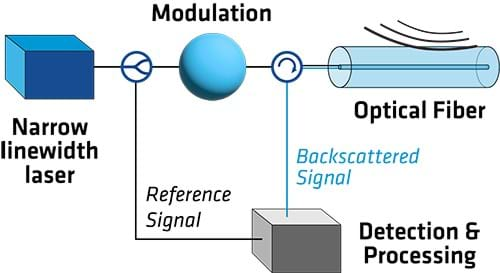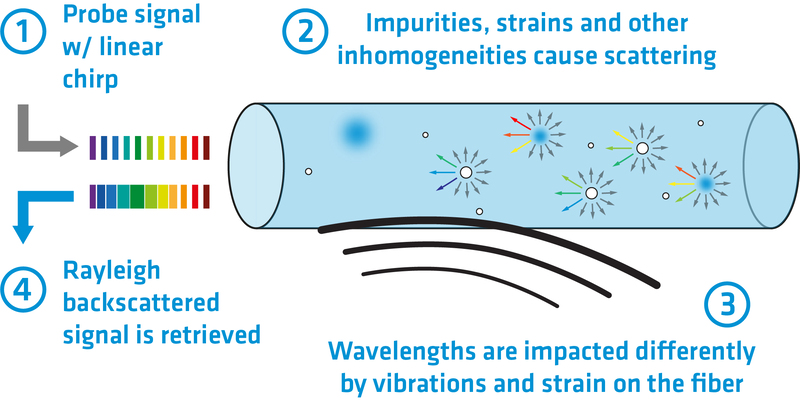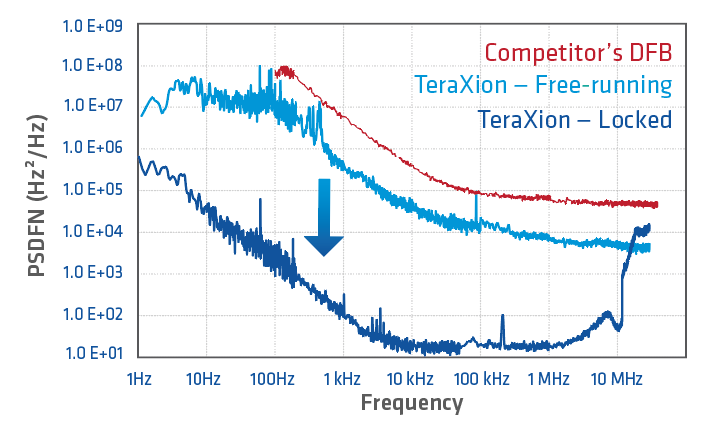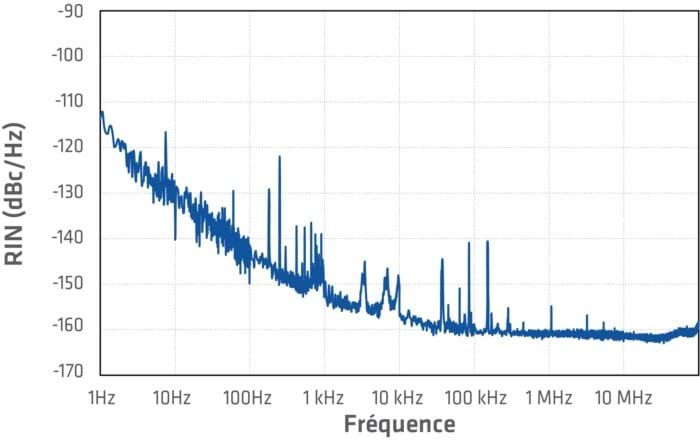Distributed Acoustic Sensing over Telecommunication Networks
On: Jul 05, 2023
In: Optical Sensing & Optical Communication
In the realm of distributed acoustic sensing (DAS), where valuable data is extracted from the faint signals backscattered by optical fibers, technological advancements continue to push the boundaries of what's possible. The use of narrow linewidth lasers has proven to be instrumental in enhancing spatial resolution, extending sensing distances, and expanding the frequency range of DAS systems. Narrow linewidth lasers offer precise and stable wavelength output, making them indispensable components for achieving the highest performance in distributed acoustic sensing.
This is particularly relevant when performing DAS on the vast and ubiquitous telecommunication networks, leveraging millions of kilometers of optical fibers already installed throughout the world.
This article delves into the significance of narrow linewidth lasers, emphasizing their pivotal role in unlocking the true potential of DAS technology on telecommunication networks optical fibers.
The Basics of Distributed Acoustic Sensing (DAS)
Distributed Acoustic Sensing is a cutting-edge technology that transforms standard optical fibers into an extensive array of sensors. By injecting laser light into these fibers and measuring the counter-propagating Rayleigh backscattered signal, DAS systems can accurately detect and analyze disturbances caused by vibrations and strain along the entire length of the interrogated fiber. This breakthrough has unlocked a plethora of applications, ranging from oil and gas pipeline monitoring to perimeter security and seismic exploration. Now, thanks to improved performance of narrow linewidth lasers and novel sensing approaches, using pre-existing telecommunications fibers further expands the potentiality of the technique by providing massive amounts of environmental data to dig into.[1]

Figure 1. Overview of DAS principles
Advancements in DAS Techniques
Phase-sensitive Optical Time-Domain Reflectometry (f-OTDR) techniques further exemplify the importance of narrow linewidth lasers in DAS applications. These techniques leverage the low phase noise of narrow linewidth lasers by propagating highly coherent light throughout the fiber and analyzing the returned signal, estabilishing a spatially resolved fingerprint of the interrogated fiber and dynamically measuring its variations. The phase recovery process then allows to quantify and locate acoustic events with high precision and accuracy, significantly enhancing the performance compared to traditional fiber sensing systems.
Below is a non-exhaustive list of common measurement approaches, which core concepts can be found in a myriad of ingenious DAS variants [2,3].
Differential Techniques
Differential detection techniques utilize phase demodulation algorithms to correlate backscattered signals to a local oscillator and extract acoustic information. Narrow linewidth lasers enable high-quality probe and reference signals required for accurate correlation measurements. The precise wavelength output of narrow linewidth lasers ensures minimal phase fluctuations throughout a measurement sequence. This enhances the accuracy and sensitivity of the DAS system, enabling effective detection and localization of acoustic events.

Figure 2. Basic coherent-detection scheme
Pulse-coding Techniques
These techniques apply autocorrelated error-correcting code sequences to the coherent pulses to retrieve the information related to perturbations, thereby enhancing detection capabilities by reducing the noise floor. Narrow linewidth lasers enable the generation of coded pulses with precise timing and minimal crosstalk. This maximizes the distinguishability of the coded signals, facilitating accurate identification and analysis of acoustic events, even in challenging environments with significant background noise.
Chirped Pulse Techniques
The use of chirped pulses adds a twist to f-OTDR with the light frequency varying over the duration of the pulse (this can even be considered a coded sequence). Following a pertubation on the fiber, the local change of refractive index will affect each wavelength in the pulse differently and generate a delay pattern correlated to the magnitude of the event. The frequency diversity provides another dimension to the measurement, thus enhancing performances in DAS [4]. High performance lasers facilitate the generation of chirped pulses with high linearity and minimal distortion, ensuring precise time-domain measurements.

Figure 3. Basic concept of chirped-pulse techniques
The Ultimate Benefits of Narrow Linewidth Lasers
Enhanced Spatial Resolution
By reducing signal distortions and minimizing pulse width enlargement, these lasers mitigate the detrimental effects of dispersion and non-linearities in the fiber, allowing for the detection of even the slightest acoustic disturbances with exceptional precision. The improved spatial resolution enables detailed monitoring and localization of events along the fiber, revolutionizing applications such as structural health monitoring and smart infrastructure management.
Extended Sensing Distances
Maintaining sensitivity and signal quality over long distances is a persistent challenge in DAS systems. Narrow linewidth lasers minimize signal degradation caused by scattering and other impairments, thereby extending the sensing distance. By leveraging the extensive reach of telecommunication network optical fibers, DAS can monitor vast areas and critical infrastructures with high fidelity and accuracy. The ability to cover extended sections of fiber for distributed sensing reduces the implementation cost, but also enables the use of longer links such as submarine cables.
Expanded Frequency Range
The frequency range over which a DAS system can effectively capture acoustic signals is of paramount importance across various applications. The range below ~1000 Hz is of particular interest as it covers city-related activities such as traffic and constructions, as well as natural phenomena such a landslides and earthquakes. It is also the most challenging range to address, mostly limited by laser phase noise at such low frequencies. High performance narrow linewidth lasers are therefore pivotal in broadening the detectable frequency range to allow for accurate detection and analysis of valuable low frequency acoustic events caught by telecommunication fibers, leading to valuable insights on infrastructure health and risks, city dynamics and seismic activity.
Addressing Challenges
While narrow linewidth lasers have long been recognized for their significance in distributed acoustic sensing, the cost-performance ratio and adaptability for massive telecommunication network deployment have hindered their widespread adoption.
With its PureSpectrum™ narrow linewidth lasers, TeraXion was able to leverage its expertise in DFB laser diode design, low-noise laser drives and frequency locking electronics. This enabled the development of ultra narrow linewidth semiconductor laser modules, displaying the enhanced stability of fiber lasers (Figure 4) with the amplitude noise of the highest quality DBF lasers (Figure 5).
These cost-effective solutions maintain performance standards suitable for widespread telecommunication network deployment.

Figure 4. Power Spectral Density Frequency Noise (PSDFN) of free-running (dark blue) and frequency-locked (light blue) TeraXion DBF lasers, compared to a competitor’s DFB laser (red).

Figure 5. Relative Noise Intensity (RIN) of TeraXion DBF lasers.
Conclusion
As advancements continue, the combined efforts in narrow linewidth lasers and DAS technology will unlock new possibilities and pave the way for transformative applications.
The importance of narrow linewidth lasers cannot be overstated, as they serve as catalysts for harnessing the true potential of distributed acoustic sensing on telecommunication networks, revolutionizing the way we monitor, analyze, and understand the acoustic environment around us.
Bibliography
[1] Ip E et al., Using Global Existing Fiber Networks for Environmental Sensing. Proceedings of the IEEE, 2022, vol. 110, no. 11, pp. 1853-1888
https://doi.org/10.1109/JPROC.2022.3199742
[2] Shang Y, Sun M, Wang C, Yang J, Du Y, Yi J, Zhao W, Wang Y, Zhao Y, Ni J., Research Progress in Distributed Acoustic Sensing Techniques. Sensors, 2022, vol. 22, p. 6060
https://doi.org/10.3390/s22166060
[3] Ogden H.M., Murray M.J., Murray J.B. et al., Frequency multiplexed coherent φ-OTDR. Sci Rep, 2021, vol. 11, p. 17921
https://doi.org/10.1038/s41598-021-97647-z
[4] Fernández-Ruiz M. R., Costa L. and Martins H .F., Distributed Acoustic Sensing Using Chirped-Pulse Phase-Sensitive OTDR Technology. Sensors, 2019, vol. 19, no 20, p. 4368
